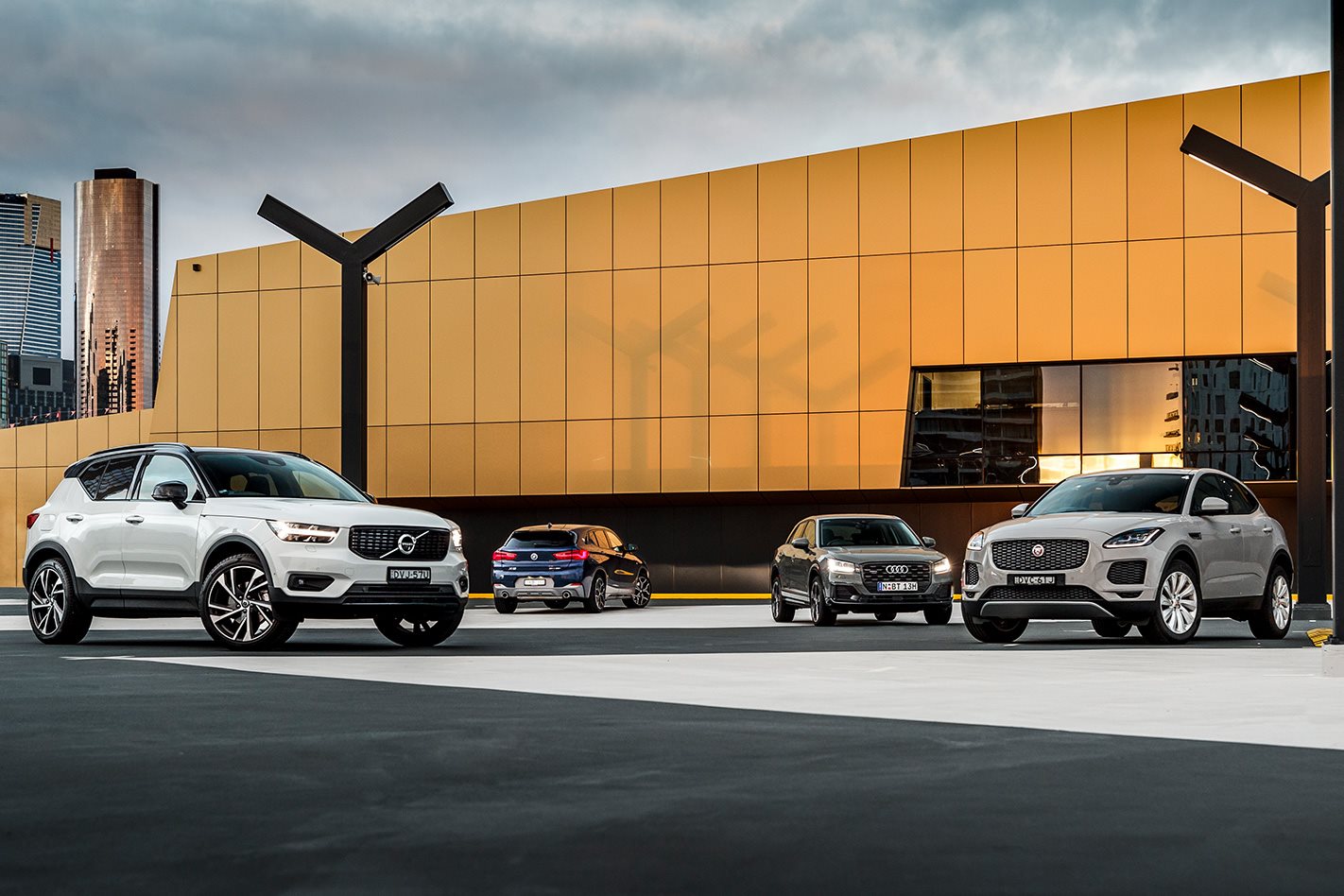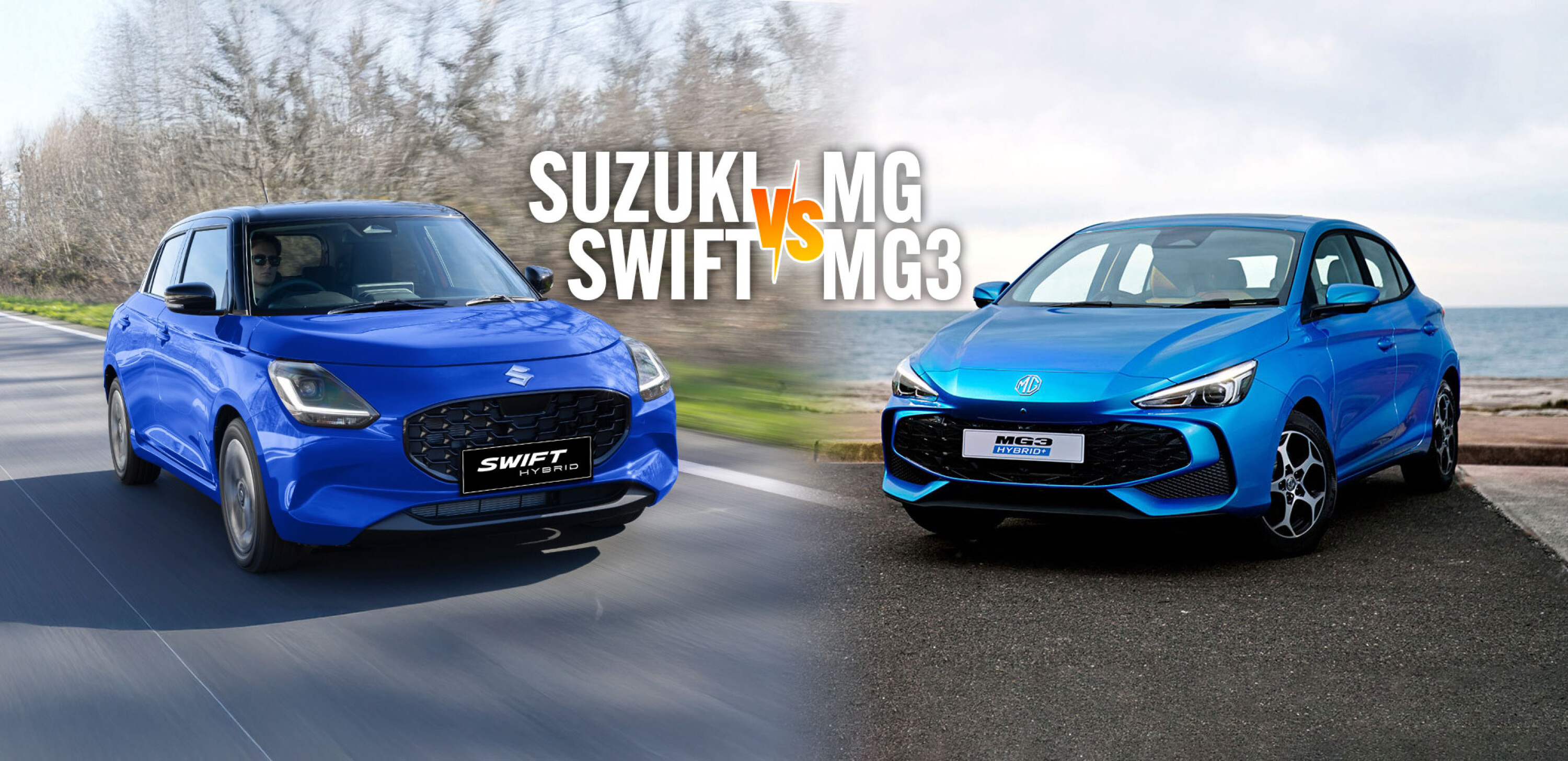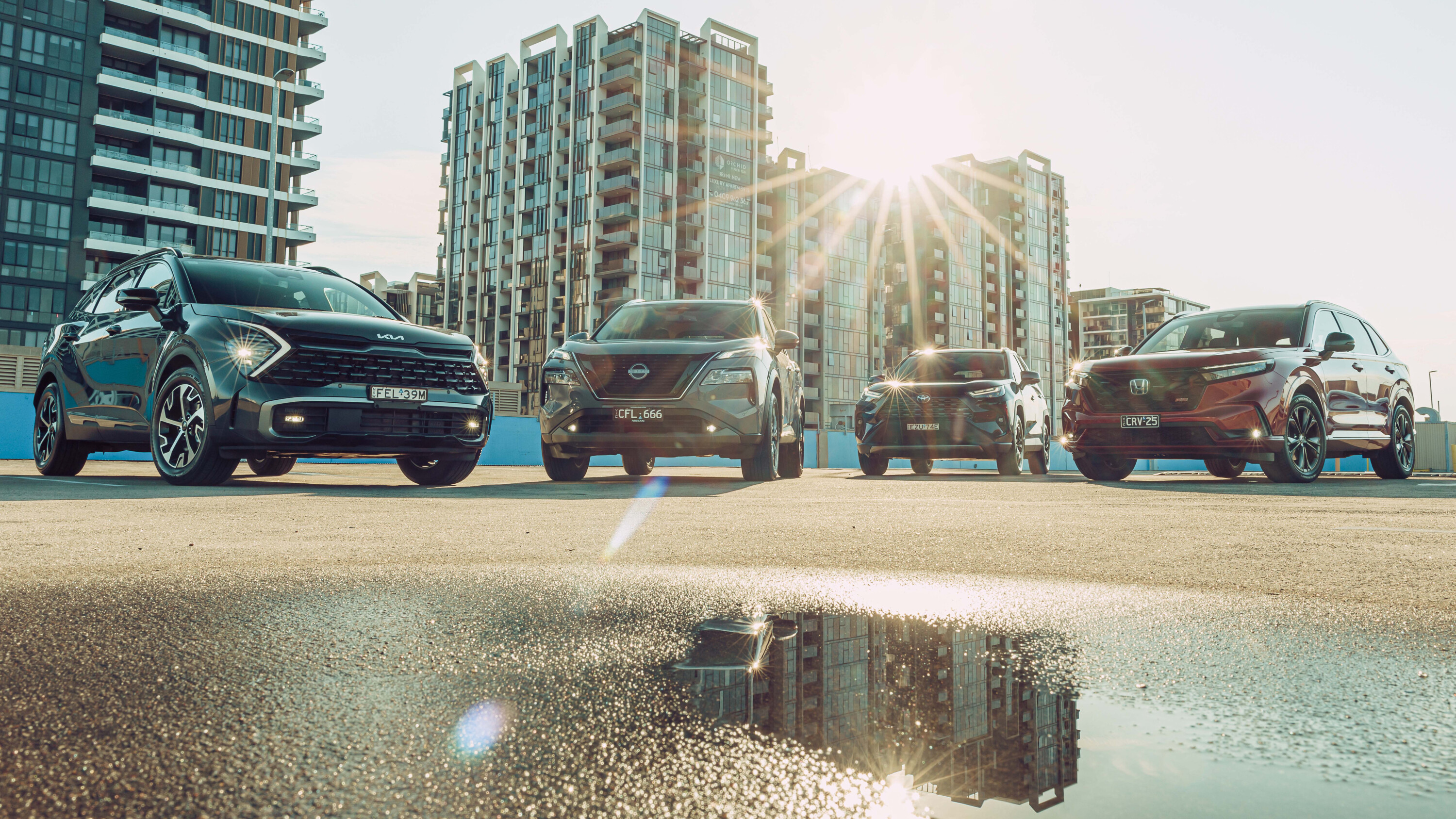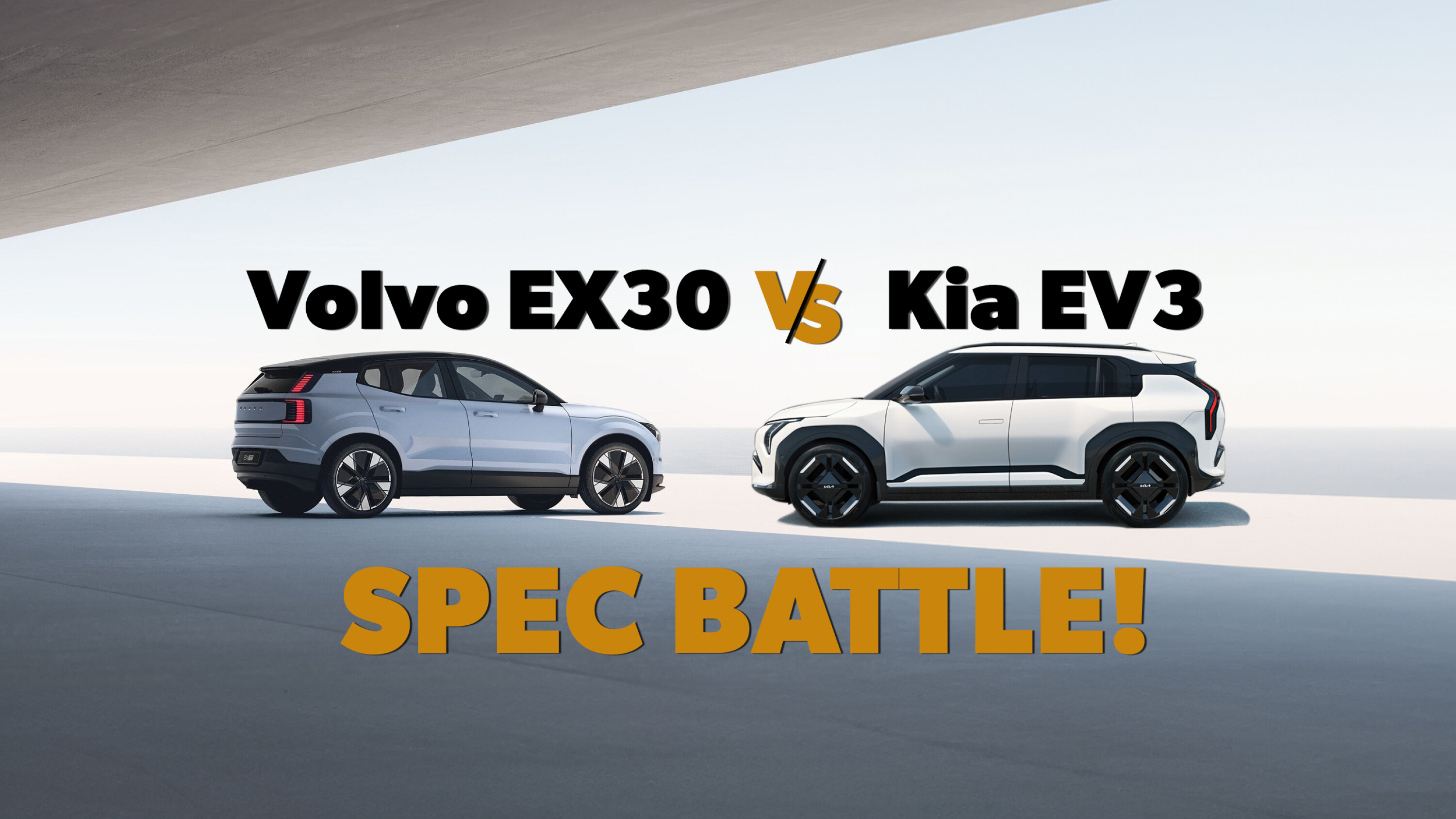NOWADAYS, the way we use apps to dine, date, hail a taxi, and even watch TV seems incredibly normal, but did anybody foresee any of this a decade ago?
Same goes for the fledgling subset of premium compact SUVs streaming into buyers’ consciousness the world over. Yes, we’d seen underwheeled frumps like the 2009 BMW X1 but until the Range Rover Evoque swaggered into view during 2011, cashed-up but compact-minded buyers simply didn’t have a seriously stylish SUV option in their sights.
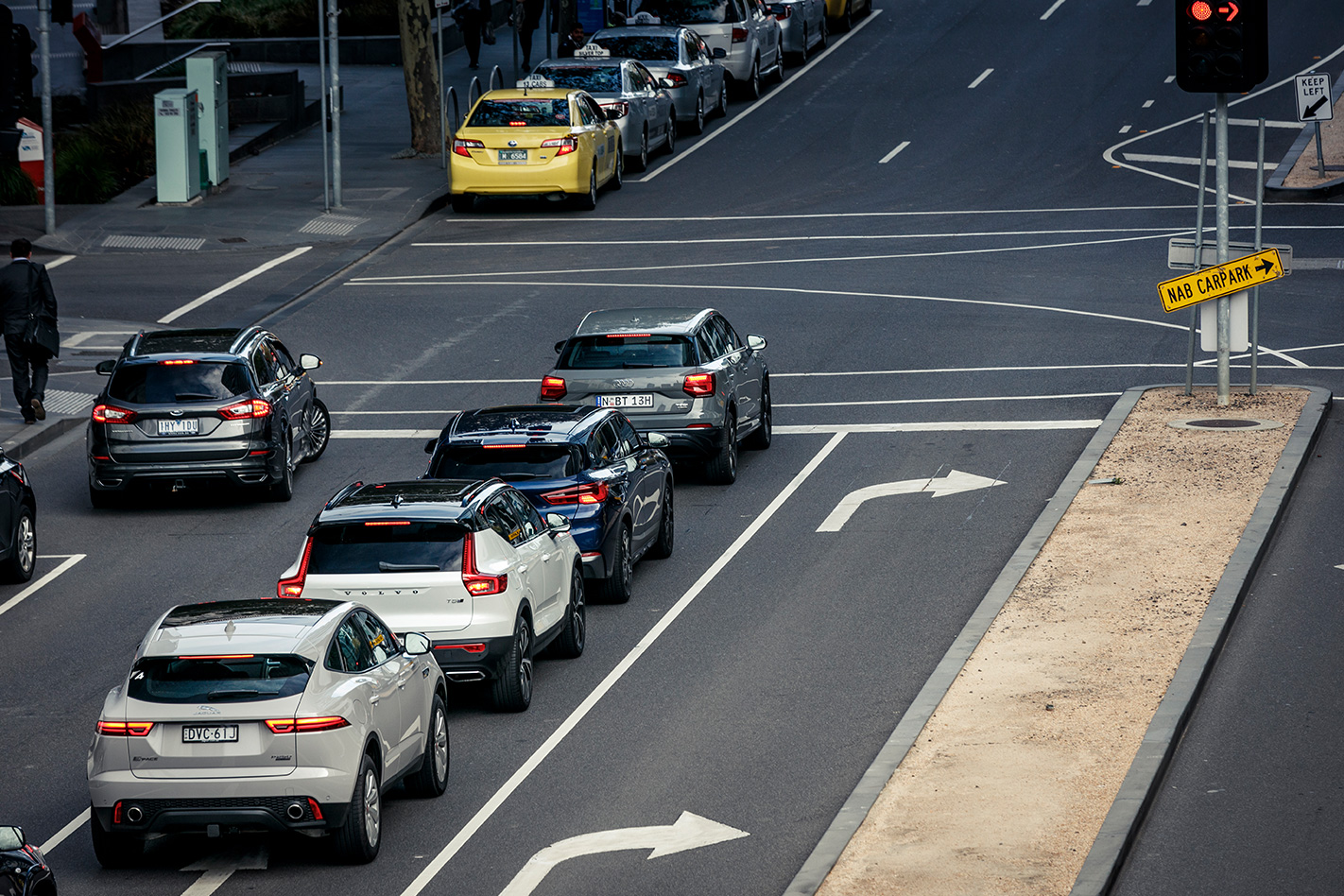
Since then, design-led premium-brand compact SUV contenders have spread like modernist furniture fanciers, driving a class that has jumped 20 percent year-on-year (or roughly the amount the premium medium set has slipped…), with the rather hatch-like (and set for replacement in 2019) Mercedes-Benz GLA currently wearing the small-SUV sales tiara.
But not for long, if the latest posse of premium petite hopefuls have their way, as witnessed by this quartet of 2.0-litre four-cylinder turbo-petrol Europeans, with the intriguing Volvo XC40 the newest kid on the block.
Described as brandishing ‘Prada trainers’ playfulness against bigger brother XC60’s ‘suede casuals’ and the full-sized XC90’s ‘black dress-shoes’ formality, the suave, distinctive Swede debuts Volvo’s box-fresh Compact Modular Architecture (CMA) co-developed with the brand’s Chinese owner Geely, and destined for a bunch of future ‘40’ series models.
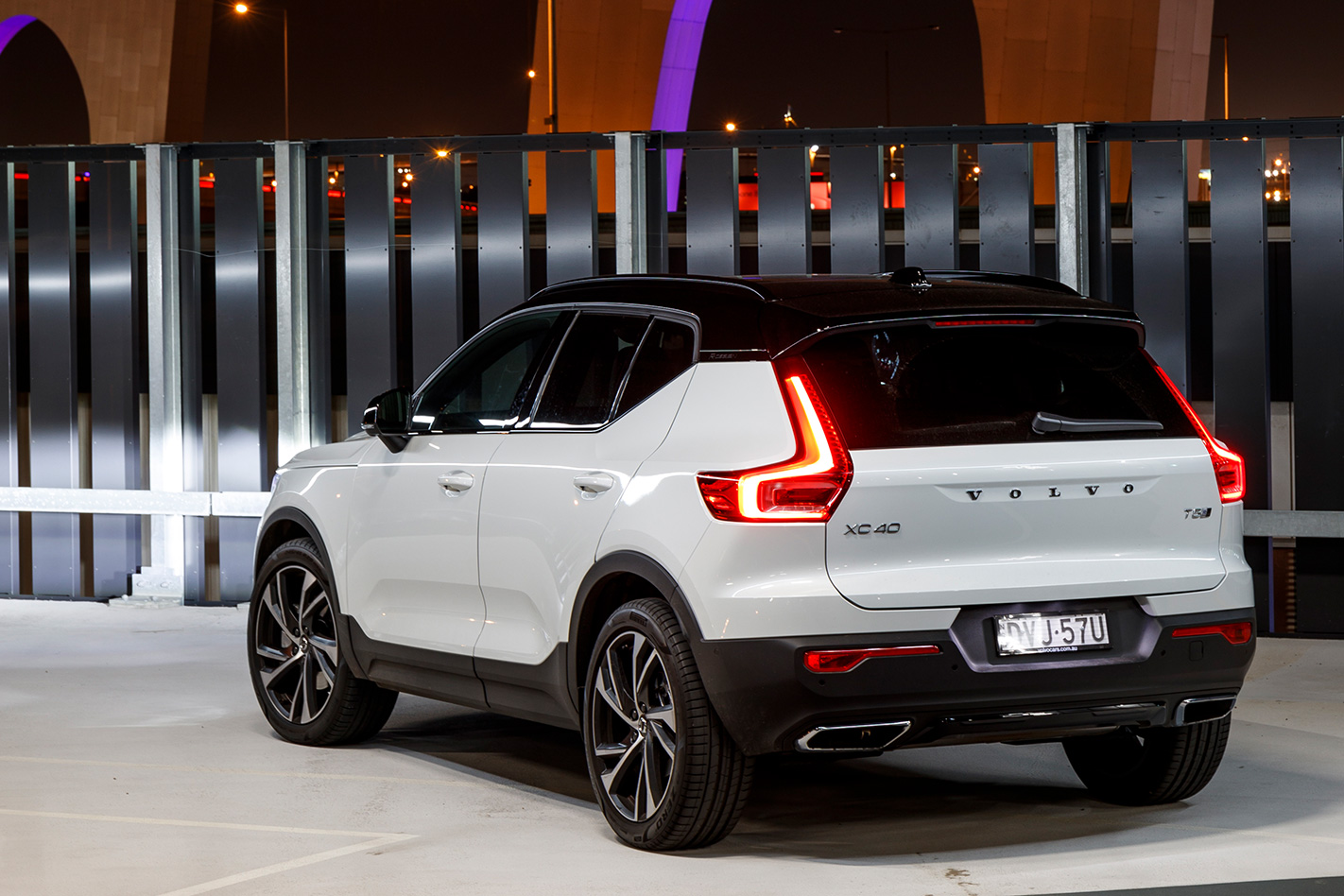
Four variants are available, each with all-wheel drive, starting with the $47,990 XC40 T5 Momentum petrol and – for $3K extra – a D4 Momentum diesel. Ours is a $54,990 T5 R-Design (the racier one that includes 20-inch alloys and a black roof, as well as a powered tailgate, leather, and cornering LEDs) in since sold-out Launch Edition semblance, adding $6670 worth of kit including heated seats, radar cruise, sunroof, park assist and high-end audio, for what is a compelling $56,740. Gothenburg is serious about ruling this nascent niche.
But so is Jaguar with its new E-Pace baby SUV, which makes a mockery of Volvo’s line-up simplicity by bombarding buyers with almost 10 times as much choice, consisting of two petrols and three diesels spanning 38 variants in total. All AWD for now, the humble D180 costs $47,750 – a record low for the marque.
That said, the Brit’s appeal is highly spec dependent. What is menacing in the $85K HSE P300 R-Dynamic looks less wildcat and more Care Bear cutesy in the S P250 at $57,600. Our Borasco Grey E-Pace tester leapt to $70,880, yet still trailed the XC40’s spec, since DAB+ digital radio and adaptive cruise weren’t included.
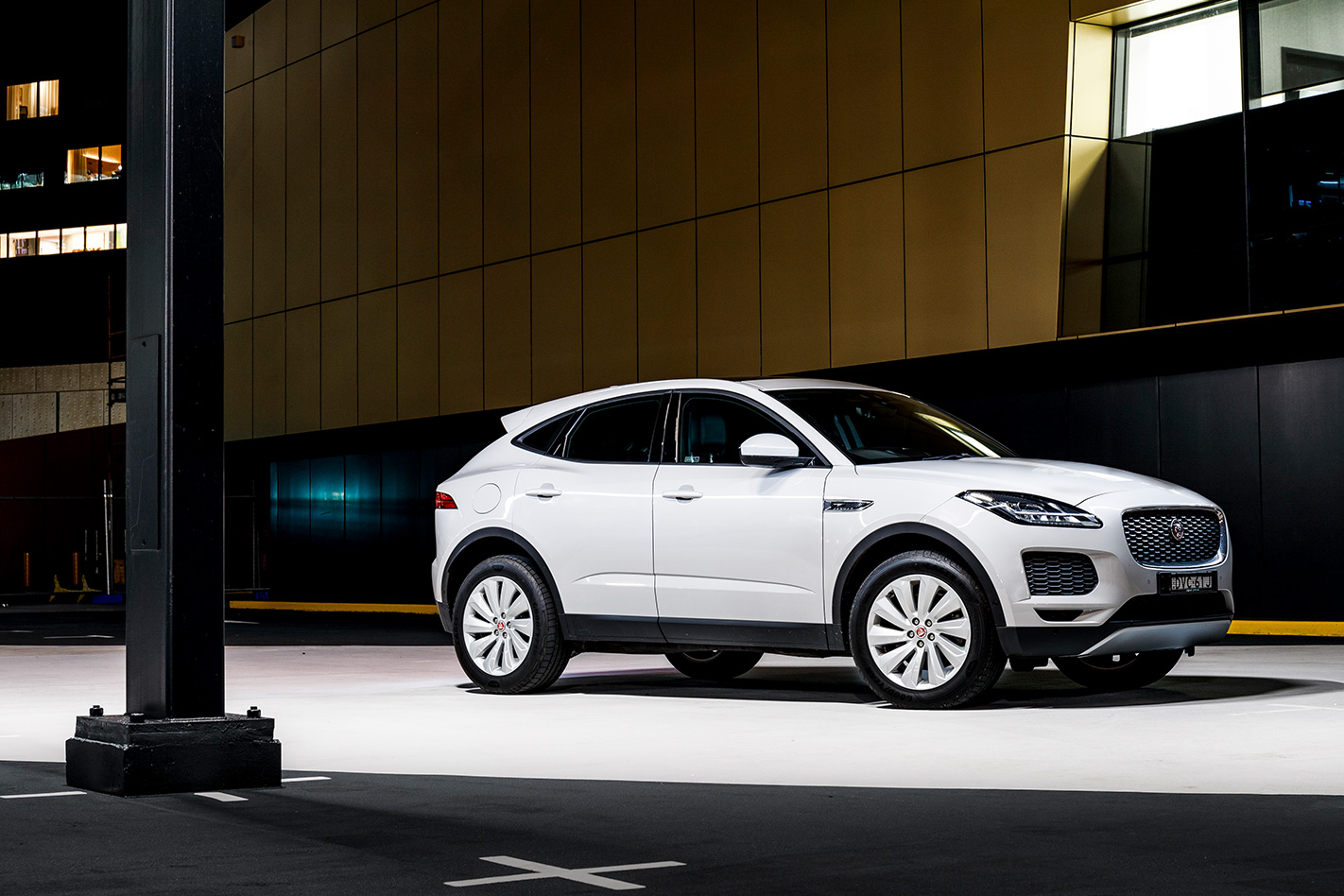
Just behind in terms of arrival and pricing is the BMW X2 from $49,900 for the sDrive18i, or $55,900 for the sDrive2.0i M Sport X Package. Our test X2 cost $66,860 due to a $4000 Launch Pack (enhanced nav, sunroof, head-up display), $2700 Comfort Pack (keyless entry plus better seats with electric lumbar and heating up front) and $400 adaptive dampers. By the way, ‘M Sport X’ translates to subtle Outback-esque body cladding.
Note, however, that ‘sDrive’ denotes front-wheel drive. For on-demand AWD parity with the others, please consult the $59,900 xDrive2.0d diesel (before options). An all-paw X2 petrol variant is not for Oz, for now.
So why not go for an X1 instead? Because, as the cliche goes, it’s the differences that make the X2 better. Sure, both sit on the same wheelbase and tracks, but the X2 is shorter, lower and wider, with slightly more front overhang yet substantially less at the rear to give it a sleeker, spunkier and aerodynamically superior silhouette. The body and platform have been beefed up, with more sophisticated dampers, better bushes and thicker anti-roll bars fitted, and the X2 gets 15:1 fixed-ratio steering (instead of a 16:1 variable-ratio set-up).
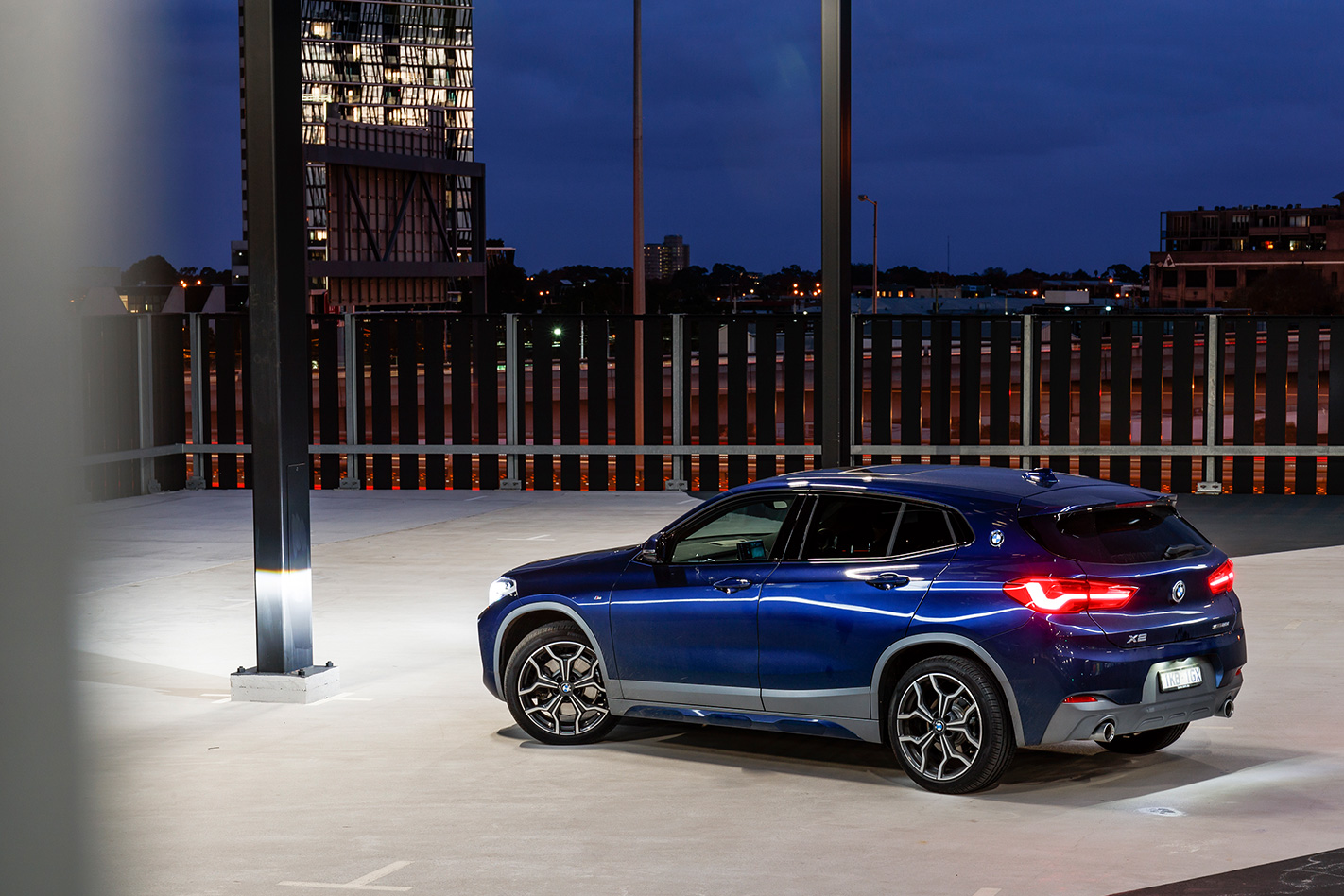
However, BMW’s controversial collision-mitigation tech (similar to AEB) still won’t perform a complete stop.
Also originating from the former federal republic is this quartet’s oldest and smallest SUV, the Audi Q2. Sharing the Volkswagen Group’s MQB A0 platform with the big new Polo and next-gen A1 (due next year), the range surfaced early last year in 1.4 TFSI front-drive petrol ($41,800) and 2.0 TDI quattro diesel ($49,100) flavours. However, we’re drawn to the fresher 2.0 TFSI quattro Sport petrol (from $48,500), particularly as it junks the 1.4’s torsion-beam rear for the TDI’s multi-link arrangement (matching the other SUVs here).
Invariably, our Q2 heaved with extras, such as a $990 Assistance package (adaptive cruise, active lane assist, blind-spot monitoring, auto high beam and park assist), $1900 Comfort pack (including keyless entry, folding mirrors, heated/electric front seats, extra compartments), and $2500 Technik pack (larger 8.0-inch screen, Virtual Cockpit instrumentation and flat-bottomed wheel), as well as $500 audio and $550 DAB+ radio upgrades.
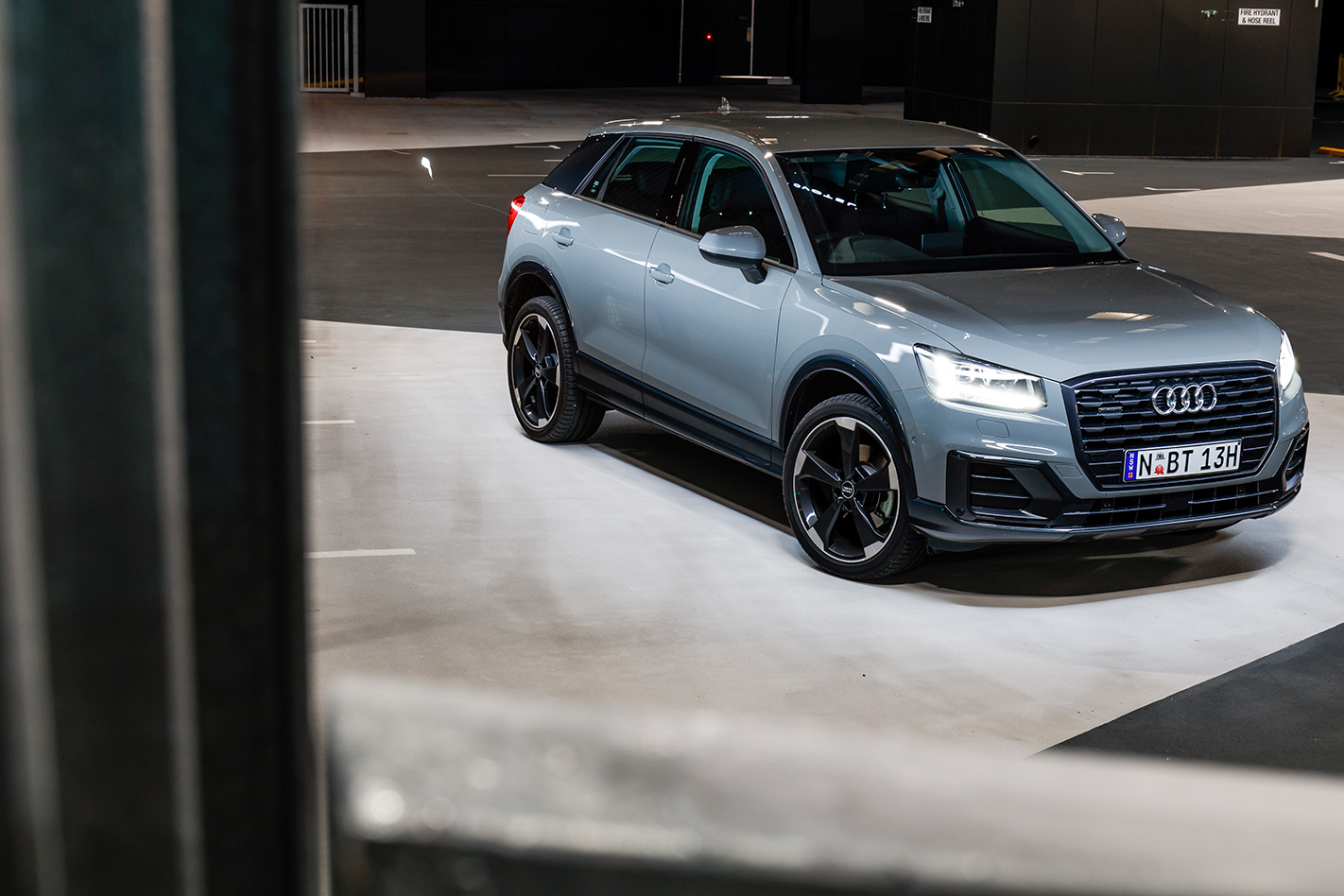
In conjunction with $900 ‘Exclusive’ styling and $500 Contrasting packs, the Audi’s personality lifts from drab to fab. Total? $59,240. That’s without a sunroof, while adaptive dampers cost a further $1500. Ouch.
Still, give or take a few items, seldom has a comparison thrown up such equipment consistency, so the $13K separating cheapest from exxiest is telling. Furthermore, while the Deutsch duo are GLA-style crossover hatches as opposed to the others more upright SUV traditionalists, there’s more – or, in some cases, less – to their packaging than meets the eye.
Take the Q2. In the showroom, its tighter proportions, missing rear air vents and annoyingly absent (but available with a $450 three-way bench option) centre-rear armrest would appear to sink its appeal. But further inspection reveals there’s actually more than sufficient headroom (in our sunroof-less car), as well as comparatively ample space for shoulders, legs, knees and feet. Seat comfort rates highly in both rows, with the rear bench offering strong lower-back and thigh support, okay vision and fairly good noise suppression.
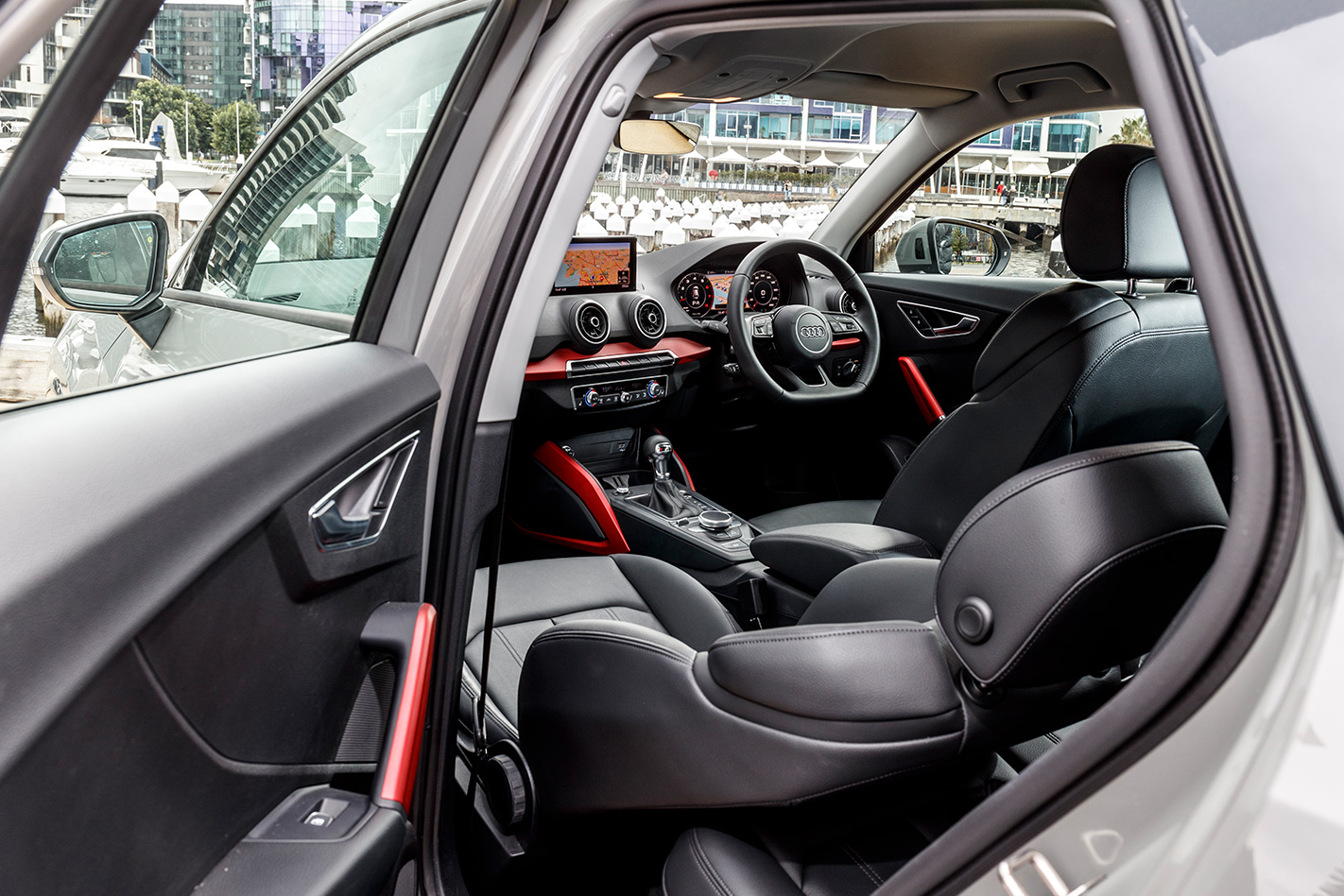
Additionally, the dashboard’s layout feels the richest as presented, with high-quality materials and finish, while the Q2’s basics for comfort, ergonomics and refinement are typically solid. It may be the smallest, but on the move and over time, the Audi’s depth of cabin craftsmanship shines through.
It isn’t quite the same in the Volvo. With the group’s longest wheelbase, highest ceiling and deepest windows, it literally stands out as the likeliest to be packing space, yet it dodges styling dorkiness thanks to deft detailing such as the R-Design’s delectable colour blocking.
Factor in the lure of sumptuously supportive front seats, Volvo’s signature central tablet screen, gorgeous instruments, classy Art Deco vents and – in this Launch Edition – stitched leather ambience, a vast sunroof and no-cost-option orange carpet and door inserts, and the XC40’s cabin is all but a flirty deed done dirt cheap.
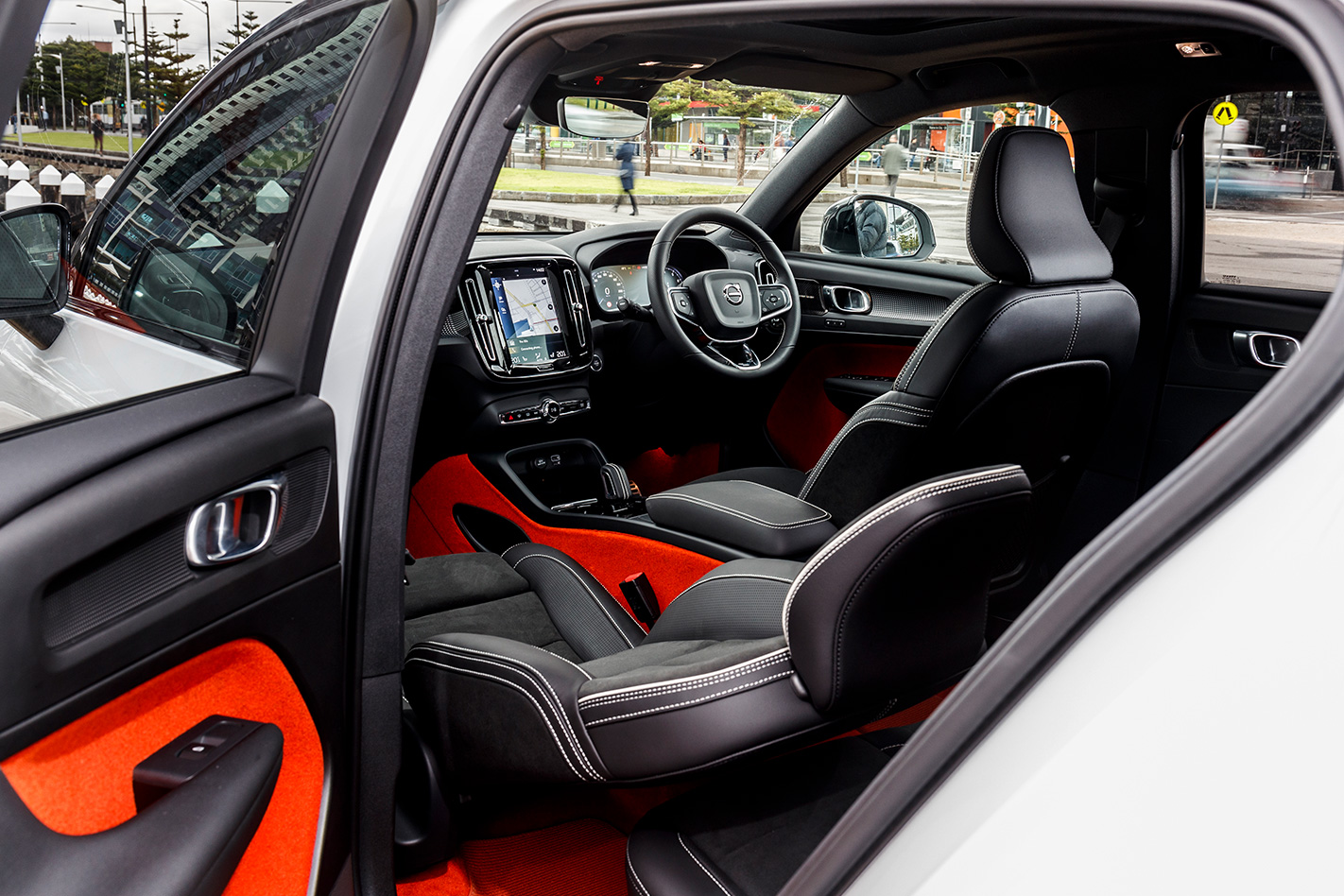
But more isn’t more room-wise (headroom aside), with less rear space than the XC40’s boxy proportions promise. Infuriatingly, each gear lever movement demands two taps; that multimedia screen’s functionality isn’t so intuitive; smallish rear cushions lack sufficient thigh support for adults; there are no proper door grabs or overhead handles to hang on to; and wind noise is a constant companion. And what happened to Volvo’s famed built-in child booster seats? They’re an especially disappointing omission seeing as the XC40’s rear window-line kink limits the view out.
The E-Pace, too, squanders the space bounties that its 1.9m width suggests. Although it appears roomier than the Swede (let alone the slender Audi), it is no more so than the narrower BMW. Just as in the XC40, some of the more out-of-the-way plastics don’t seem as savoury as its lofty pricing would suggest; the front seats are soft but also a tad shapeless and not so supportive on longer journeys; and a high rear floor forces a less-comfy knees-up posture for beanpoles out back.
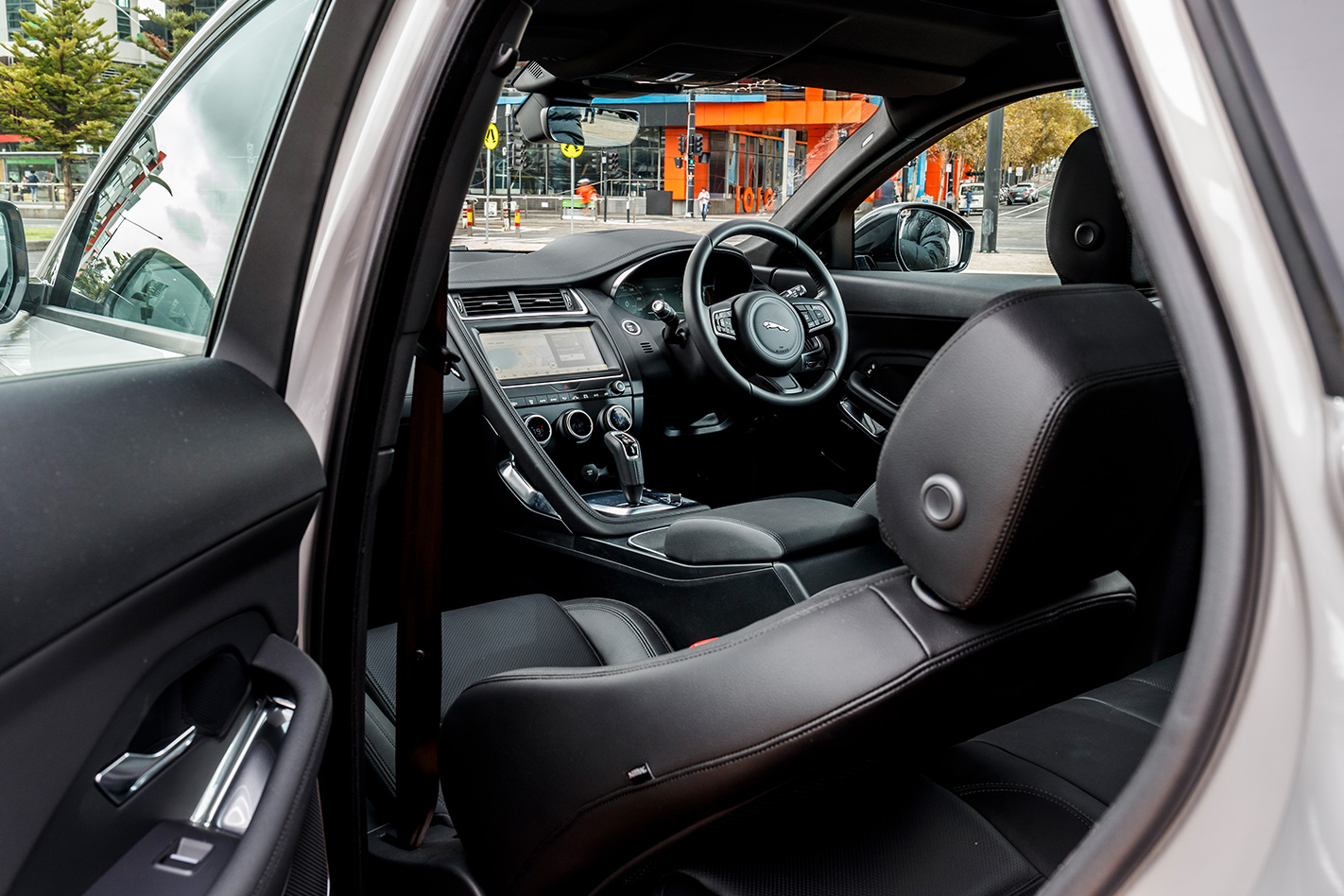
On the flipside, the Jaguar’s entry/egress is the best here, it is quiet inside, with plenty of legroom in the rear, good vision, and no shortage of USB sockets, cupholders or storage options. The dash possesses a congenial simplicity, the 484-litre boot is the biggest here and the Jag’s driving position is appealingly low-slung and enveloping. Maybe it’s the F-Type relation.
Not surprisingly, a similarly sporty atmosphere infuses the BMW, thanks to superb (though optional) seat-support enhancements, thoughtful ergonomics, uncomplicated iDrive multimedia, ample airiness in the rear (due in part to narrow front buckets), with reclining backrests and room to stretch out. The hemmed-in feel the lowered roofline hints at does not materialise.
There’s little to berate the X2 about, aside from some wind rustle around its oversized mirrors, ever-present road noise, a vision-reducing high waistline, and the roof-mounted centre back seatbelt, which is fiddly and makes for awkwardly intimate neck contact on some people.
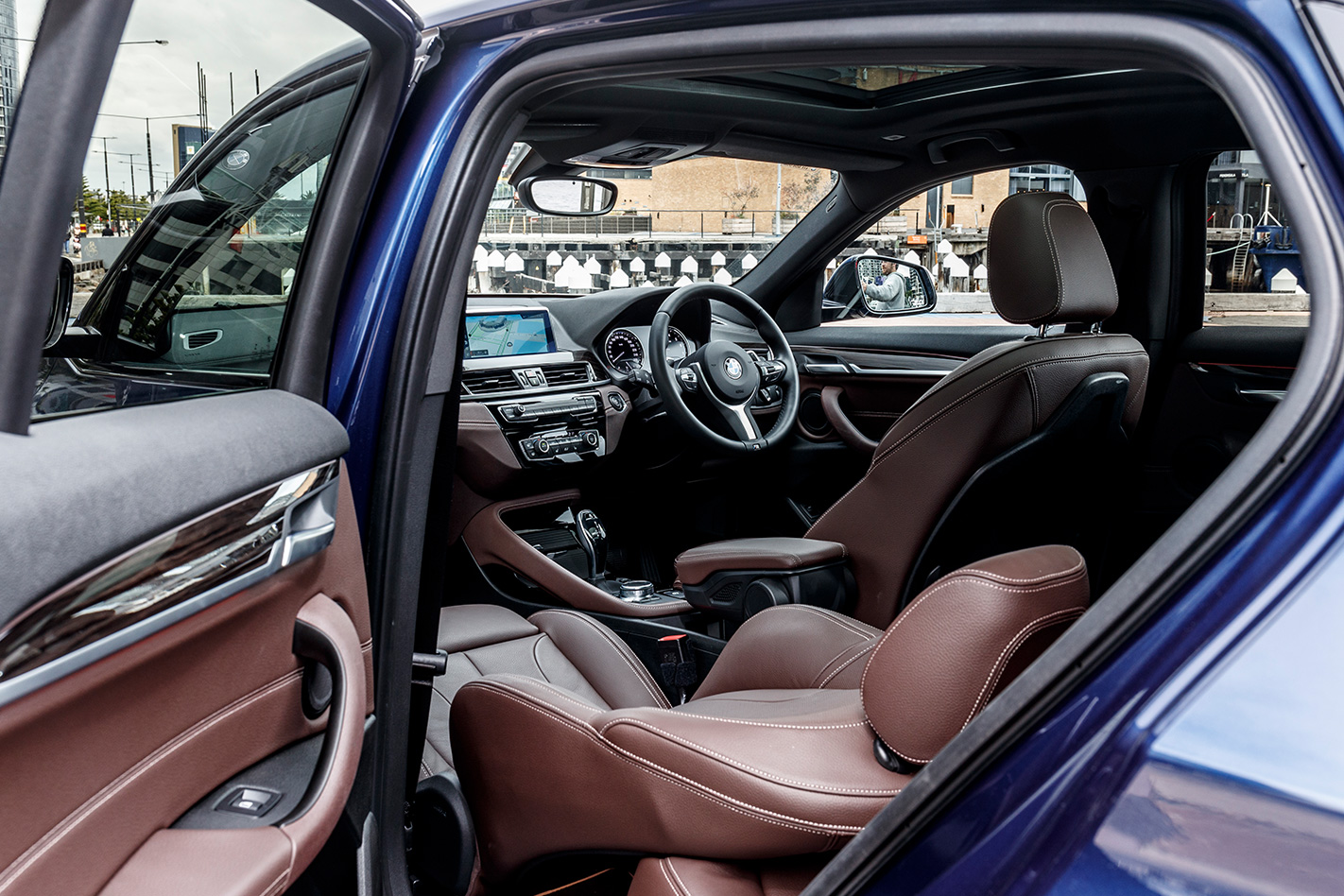
It’s not just in packaging that the smaller Germans punch above their perceived abilities. Though eager 2.0-litre turbo-petrol fours are common, their outputs vary greatly, with 140kW/280Nm (X2) and 141kW/320Nm (Q2) paling alongside the E-Pace P250’s 183kW/350Nm and XC40 T5’s 185kW/365Nm.
However, effective girth control allows the substantially lighter Germans to deliver from a standing start. The X2’s acceleration is only half a second behind the feisty Q2’s 6.7sec 0-100km/h PB, equalling the (barely run-in) Swede and eclipsing the bloated Brit by almost a second. Regardless of its output shortfalls, the X2 sDrive20i is strident off the mark and hungry through the mid-range, backed up by a quick-witted dual-clutch gearbox that’s always on the money with the right ratio. The Bavarian also proved second-quickest from 80 to 120km/h, and when stretched beyond 150km/h, it pulls away from the entire pack.
Where the Audi’s powertrain shines brightest is in two seemingly conflicting areas – its velvety point-to-point thrust combined with outstanding real-world efficiency. Flexible down low, yet thriving on high revs, the 2.0 TFSI quattro blitzes along at a cracking pace, especially when in Sport mode, as there’s plenty of extra poke to explore in the engine’s upper reaches.

Like the BMW, the seven-speed dual-clutch seems terrifically in tune with the available power. Yet, even when caned, it managed a respectable 9.0L/100km, to be the only single-digit achiever – a litre less than the X2 and more than 25 percent better than the Volvo’s disheartening 12.1L/100km average.
The Jag’s 10.7L/100km consumption wasn’t bad considering how much harder that new-fangled Ingenium four-pot turbo has to work to overcome the E-Pace’s mass. The P250 actually feels pretty muscular, shuffling imperceptibly through its nine ratios for decent accelerative thrust. Only beyond triple digits does its weight burden wash the pace away.
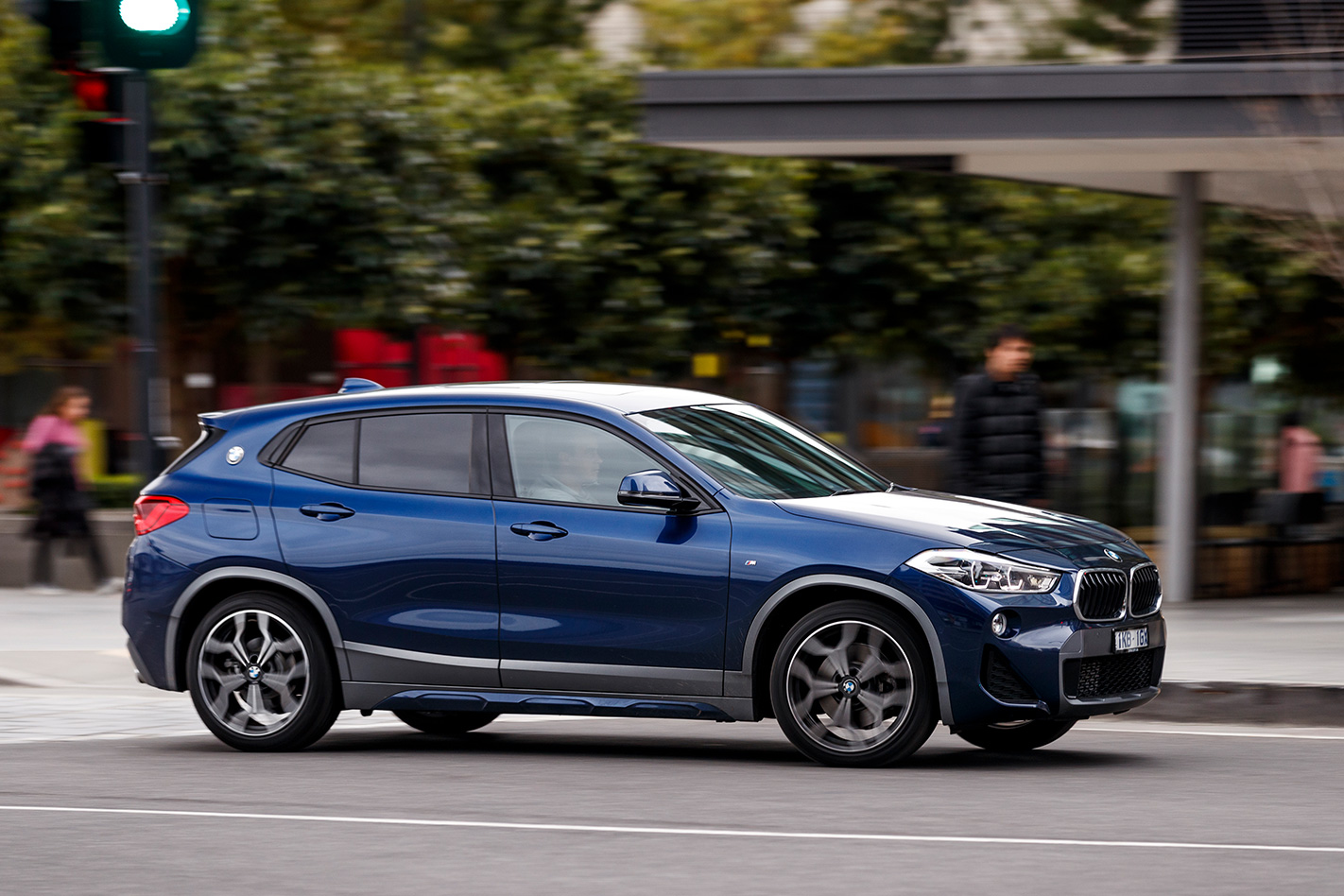
Both the Swede’s fuel consumption and acceleration will improve with mileage. But even without that advantage (which our Q2 had, with 10,000km under its belt), the XC40 has ample urge in reserve, with its lusty yet refined engine reacting willingly and smoothly to pedal inputs (as its vigorous 4.6sec 80 to 120km/h time suggests), and it even seemed to loosen up as testing kilometres piled on.
Light and breezy, the Volvo’s steering seems perfectly suited to its intended urban habitat, providing for ease of manoeuvrability. Ride quality with two on board is also pleasant around town, and up there with its rivals in dealing with low-speed bumps, thumps and tram lines.
Where the XC40 wilts somewhat is through faster bends on rougher roads. The steering’s remoteness turns into disconnection for the driver mid-corner, undermining confidence, even with sticky 245/45R20 Pirelli P Zeros providing significant grip. Furthermore, even at moderate speeds, the suspension can seem busy, transmitting lots of little shocks into the cabin, particularly to the rear passengers, who are already dealing with inadequate cushion support.
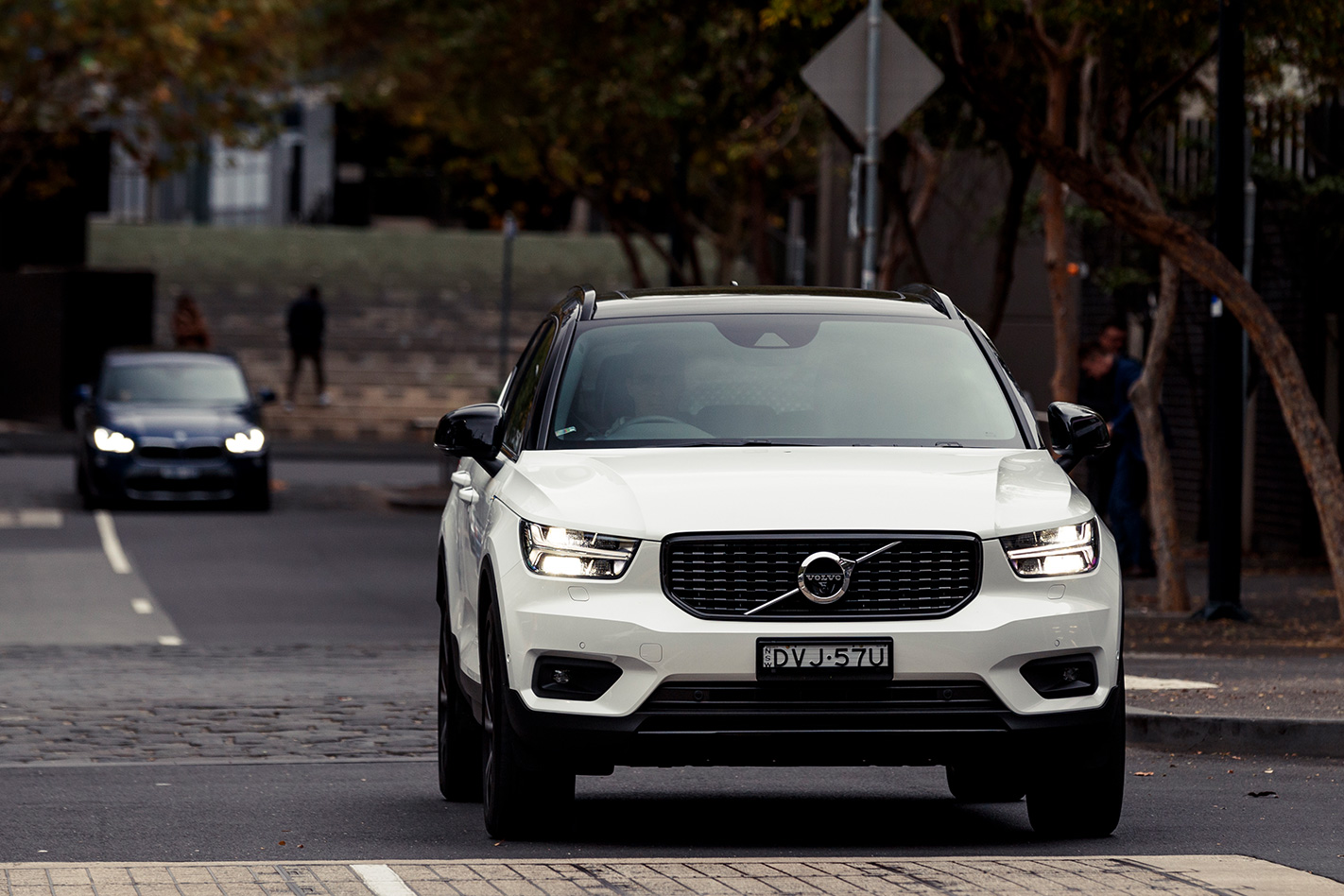
The R-Design Launch Edition is betrayed to some extent by its excessive wheel size (20s versus the others’ 19s) without the assistance of optional adaptive dampers (present here only in the BMW) to help smooth the ride.
While a plush suppleness around town is right on Jaguar’s USP, the E-Pace’s dynamics, too, wither a little on rural roads, trailing the Volvo with noticeable (and at times nauseating) lateral body movement to go with its vertical pitching at speed.
This is doubly disheartening because the Jaguar’s steering is a joy, providing the crispness, feel and feedback of a smaller car – in this case, the excellent XE – in equal measure. On smooth surfaces the chassis’ agility is noble for such a portly beast, though ultimately a top-heavy nervousness dissuades press-on driving.
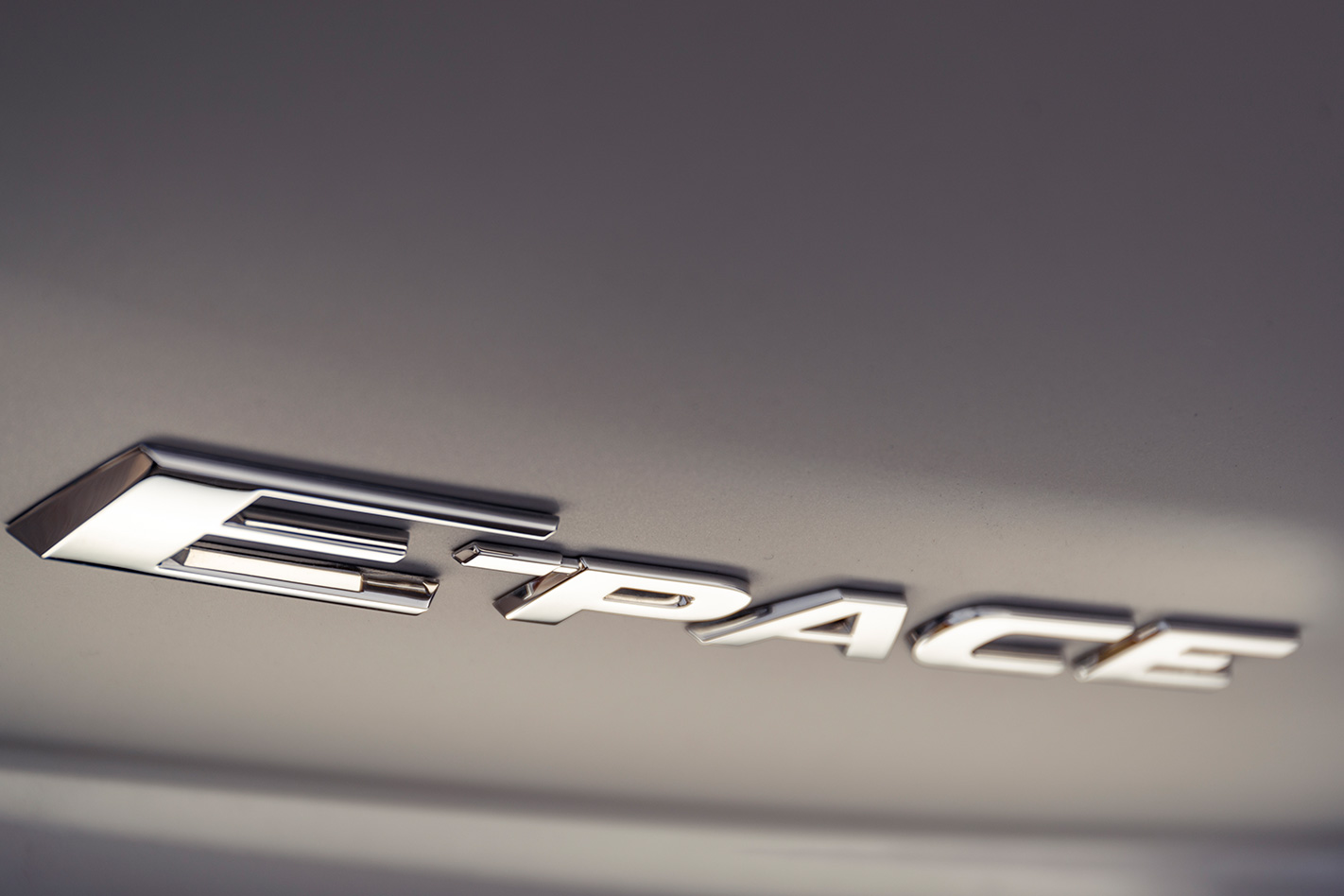
In contrast, that’s what the X2 feels born to do. It’s better than any BMW SUV in recent memory, with bite, consistency and surety in its handling and grip that makes it refreshingly good fun. However, the steering is still devoid of feel and could use more weight at speed, and the Mini-derived front-drive underpinnings can bring torque steer on greasy or wet surfaces.
Run-flat tyres make the BMW’s ride brittle over rough bitumen, but the must-have $400 adaptive dampers smother the lumps in most situations, apart from its abrupt reaction to concrete road joins. X1 owners will marvel at the progress displayed here, though not as much as we did at the Q2 2.0 TFSI quattro, which feels entirely unrelated to the noisy and agitated 1.4 TFSI front-drive we tested last year on the same roads.
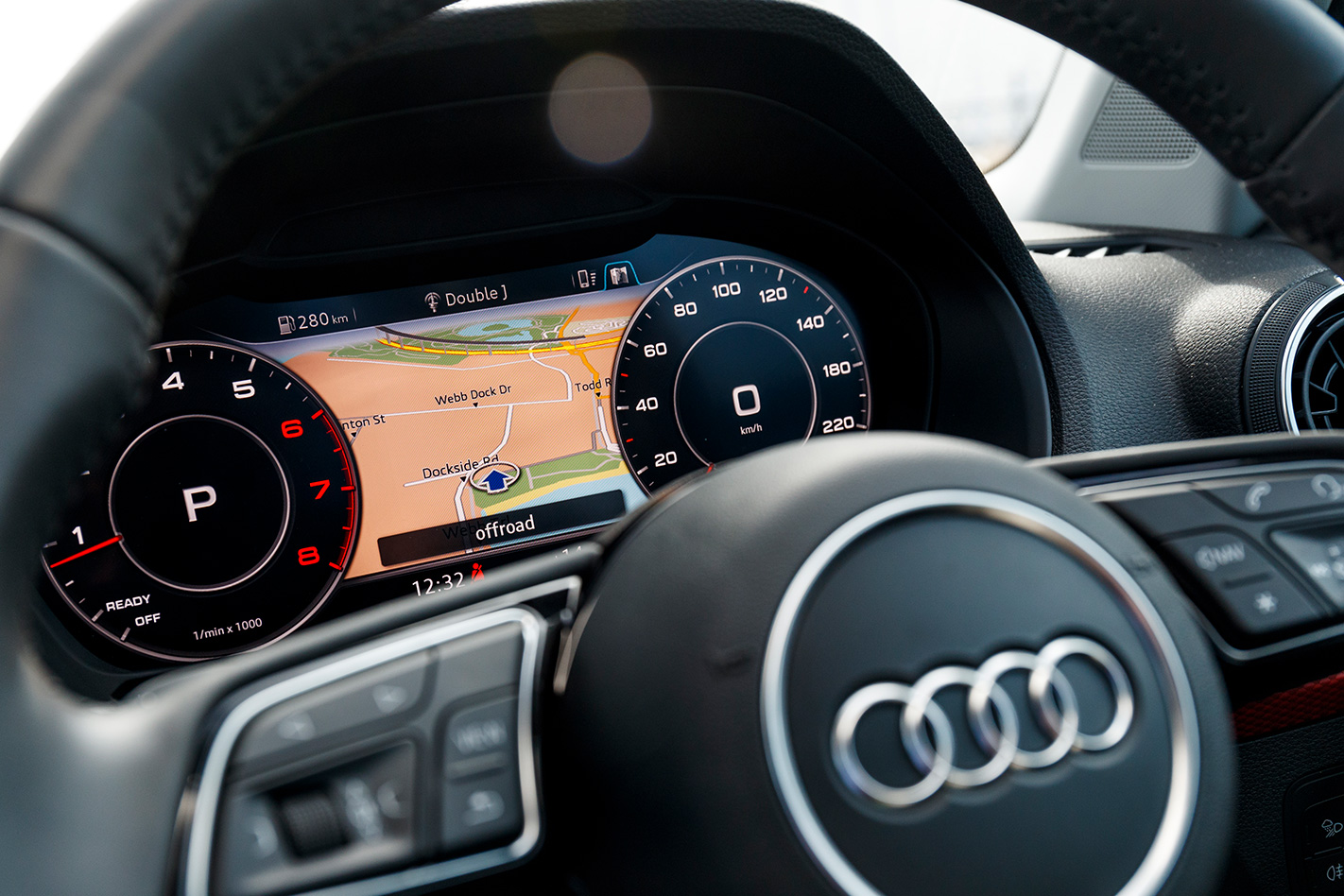
Yes, the Q2’s suspension is firmer than that of the non-Germans, but there’s better control and discipline in the very non-SUV manner in which it deals with the surface, delivering a comfortable and calm experience. That it’s considerably smaller and lighter than everything else here is largely behind its dynamic advantage, boasting rewarding steering and a chassis that’s nimble and forgiving. Whether that’s adequate compensation for its packaging shortcomings is an altogether thornier issue.
The Jaguar E-Pace is a case of the converse. While it’s far from a loser, the likeable Jaguar SUV isn’t quite on the, er … pace. Spacious, plush and hushed at urban speeds, there’s neither enough equipment to justify its price, nor the dynamic finesse when pressed to fit the marque’s resurgent image.
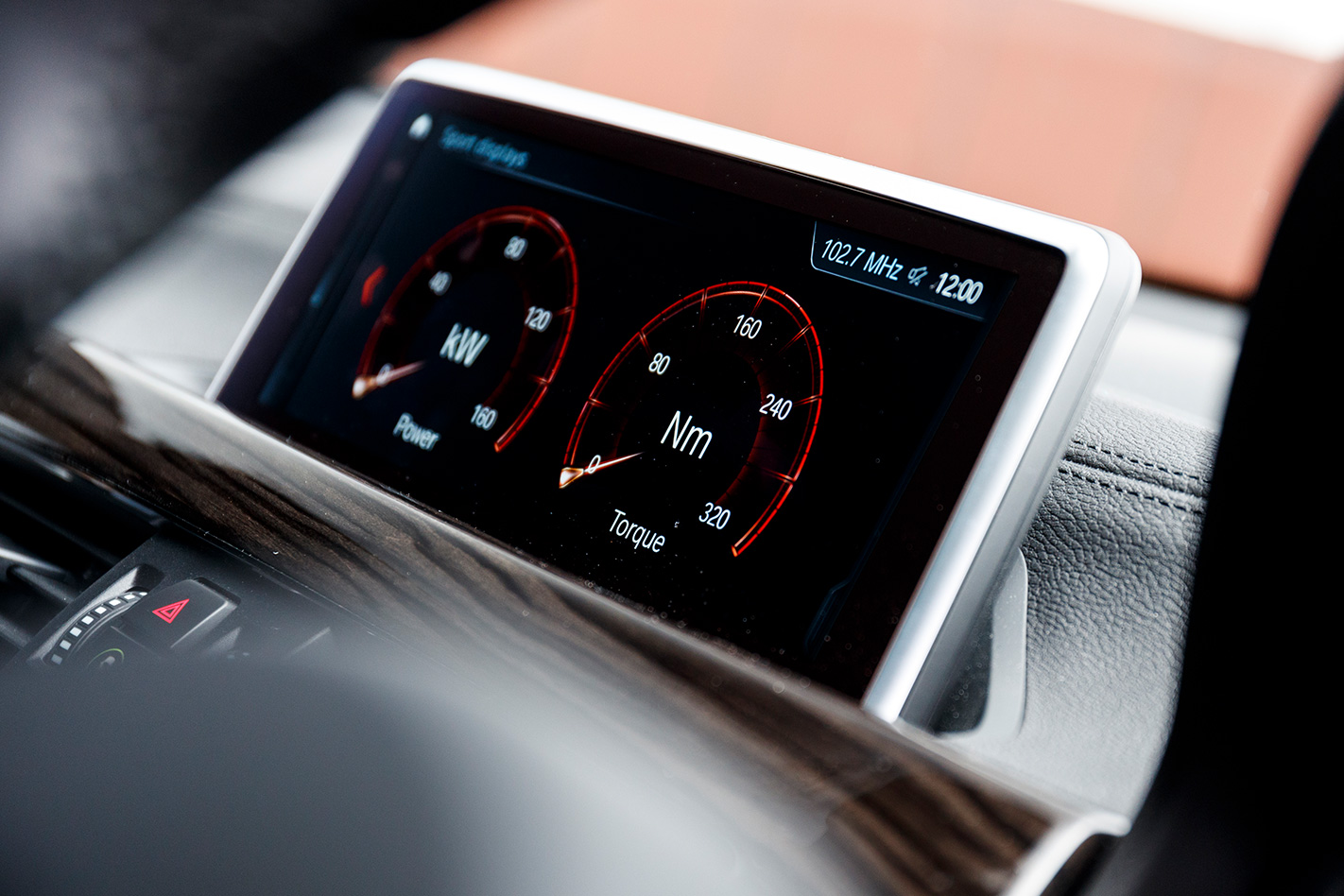
The X2, on the other hand, is an unanticipated and welcome return to form for BMW. Accommodating, engaging and cosseting in equal measure, it’s Munich’s best SUV. But the sDrive20i is expensive considering its meagre kit and the need for optional adaptive dampers, not to mention torque only going to the front wheels.
In 2.0 TFSI quattro guise, the dinky Audi finally delivers on its initial promise, just as long as you’re forensically picky with the necessary options list.
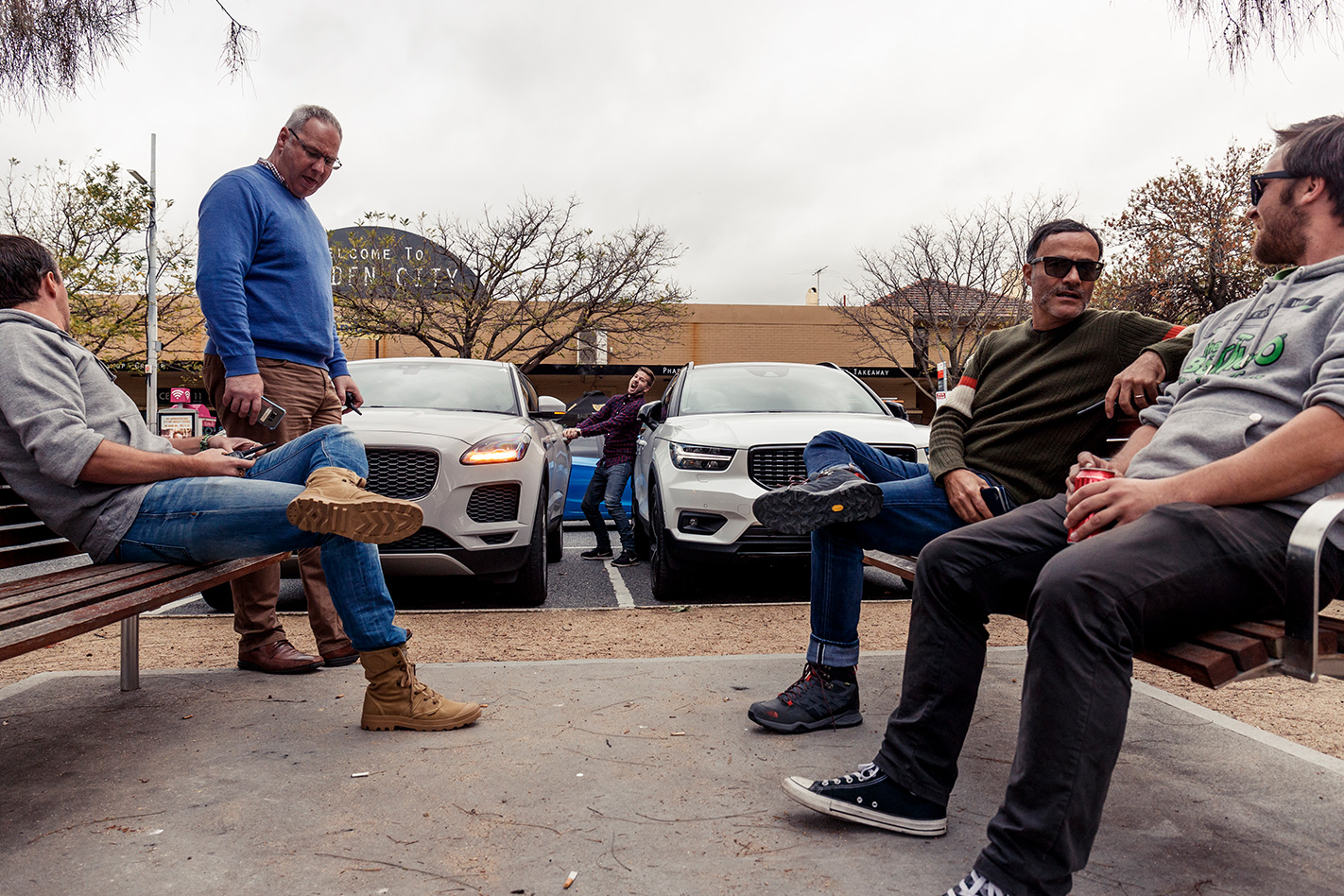
The Volvo reqires no such immersion in spec sheets. That said, the XC40 Launch Edition’s static dazzle, crushing equipment superiority and socially acceptable image needs to be balanced against its comparatively numb steering, busy suspension and high fuel consumption. The Volvo was odds-on to steamroller the competition, yet only does enough to squeak a decision here. Just like Netflix, Uber and the whole damn premium small SUV thing, nobody saw that coming.

